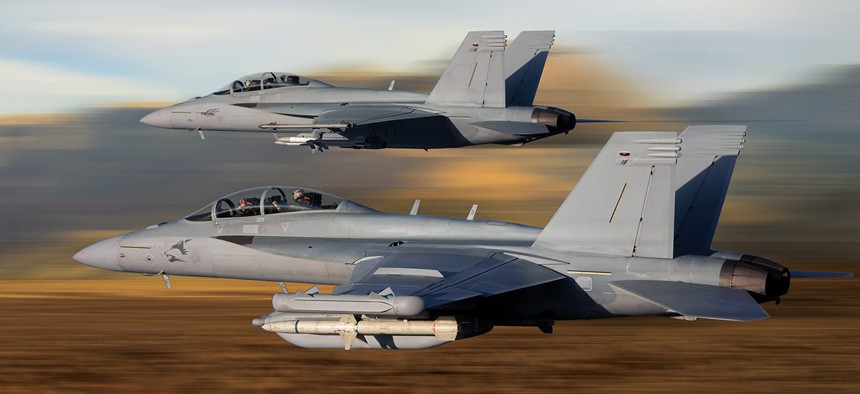
Two F/A-18s aloft in 2015. Photo via Boeing
Boeing to Cut 50 Executives, Reorganize Defense Business
Fresh off a move to from St. Louis to Washington, the firm’s defense division says it’s removing a layer of bureaucracy.
Aerospace giant Boeing will reorganize its defense and space business, eliminating dozens of executive billets and creating new business units for fighter jets, drones, space and helicopters.
Leanne Caret, CEO of Boeing Defense, Space & Security, announced the move Tuesday afternoon. She said the changes would allow quicker decisions and better position the company to win business.
“We need to be an agile organization that is more responsive to customers’ needs and committed to continually improving productivity,” she said in a statement.
Caret is expected to provide more details about the reorganization in a live interview at the Defense One Global Business Briefing on Wednesday morning, in Washington, D.C.
The big question is “Why now?” said Byron Callan, an analyst with Capital Alpha Partners, who said it would be tough to pinpoint a specific bid that the company lost that might have spurred the reorganization. “My candidates would be either it’s classified or…the bomber loss is something that has resonated within the organization and they feel that they maybe need some tighter attention to stuff."
The organizational overhaul is effective July 1 and affects about 50 executive positions. It’s unclear what will happen to those employees, who were notified of the moves on Tuesday, ahead of the public announcement.
RELATED: The Future of Boeing Defense, According to Its New CEO
RELATED: Boeing to Move Defense Headquarters from St. Louis to DC
RELATED: Boeing, Shipbuilder Team Up to Build Giant Underwater Drones
“Currently, there are on average seven layers of management between a shop-floor technician and Leanne Caret,” said Todd Blecher, a spokesman for Boeing’s defense business. “Effective July 1 there will be no more than six. An entire layer of executives, mostly between program managers and division presidents, is being eliminated.”
The firm will also disband two of its four units: Boeing Military Aircraft and Network & Space Systems. Their efforts will be pursued in four smaller segments:
- Autonomous Systems, headed by Chris Raymond, will include drone-makers Insitu and Liquid Robotics. It will also handle the Echo Voyager sub drone; vertical lift unmanned systems; and “certain electronic and information systems.”
- Space and Missile Systems, to be run by Jim Chilton, will handle Boeing’s satellites, the company’s share of United Launch Alliance; International Space Station work; Ground-based Midcourse Defense missile interceptors; the firm’s pursuit of the Ground Based Strategic Deterrent (new ICBMs); and various weapons including the Joint Direct Attack Munition and Harpoon missile.
- Strike, Surveillance and Mobility, to be led by Shelley Lavender, will be in charge of Boeing’s signature aircraft programs: F-15 and F/A-18 fighters; P-8 maritime patrol aircraft; and modifications and upgrades to fixed-wing aircraft. The unit will also run the company’s pursuit of a new Joint Surveillance Target Attack Radar System for the U.S. Air Force.
- Vertical Lift, under David Koopersmith, will build the AH-6i, AH-64 Apache, and CH-47 Chinook helicopters; and the V-22 Osprey tiltrotor, which Boeing builds jointly with Bell Helicopter.
The company’s Development, Global Operations, and Phantom Works segments “will largely be unchanged,” the company said in a statement.
The creation of the Autonomous Systems sector could be seen as a way to better incorporate Insitu into Boeing and better position itself for future drone business.
The reorganization is Caret’s latest move since she took the helm of the firm’s defense unit in February 2016. Later that year, After several months of debate, Caret moved Boeing’s defense headquarters from St. Louis to Arlington, Virginia, within eyeshot of the Pentagon and U.S. Capitol, so she and other executives could have more face time with military and political leaders.




